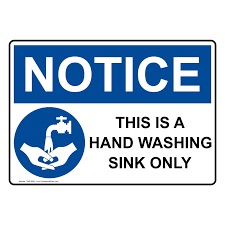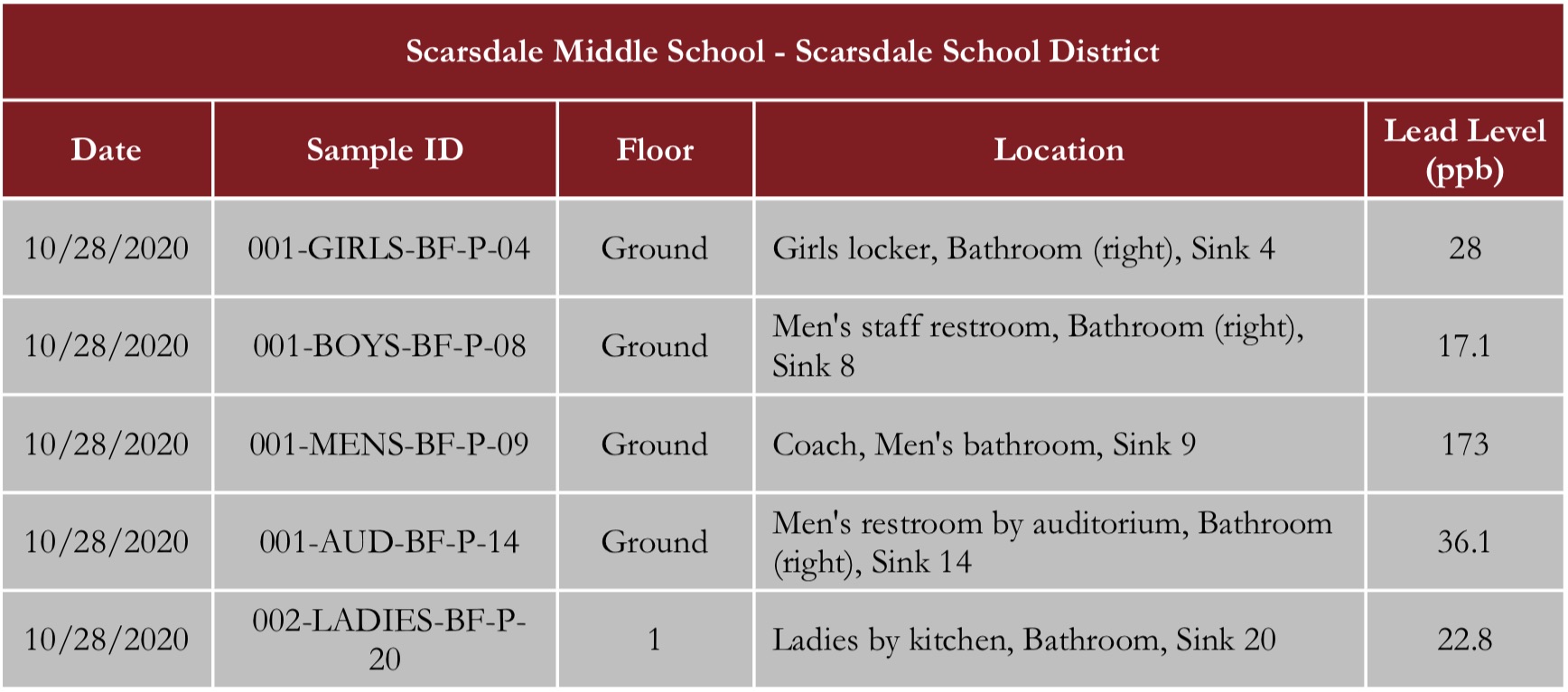High Levels of Lead Detected in Some School District Sinks
- Monday, 30 November 2020 17:18
- Last Updated: Wednesday, 02 December 2020 13:53
- Published: Monday, 30 November 2020 17:18
- Joanne Wallenstein
- Hits: 3506
 Water testing done in October 2020 at the Scarsdale Schools reveals that lead levels are too high in some outlets at all the schools, requiring lead filters or signage warning against drinking the water.
Water testing done in October 2020 at the Scarsdale Schools reveals that lead levels are too high in some outlets at all the schools, requiring lead filters or signage warning against drinking the water.
The NYS Department of Health requires that action be taken when the lead levels are above 15 parts per billion, which translates to 15 micrograms per liter. At Scarsdale Middle School, where legionella bacteria was found in the water in September, water in 25 outlets was found to exceed acceptable levels, with one sink measuring 528 ppb, 35 times the acceptable level. Sinks in the Cooper House, Butler House, Popham House and Fountain House lunchrooms all tested too high, signaling that this water was not acceptable for cooking and cleaning. In one sink in the Butler Cafeteria, the level was measured at 88.7.
The prolonged closure of schools due to COVID increased the risk to the water system. In September, legionella bacteria was found in the water at Quaker Ridge School and the middle school. After the legionella finding in September, the district installed UV/lead water bottle filling stations in the school and all of these have safe drinking water.
In response to the most recent lead test results, outlets with lead levels above the action level were removed from service, except sinks for handwashing. On those sinks, signage is posted to warn against drinking the water. All sinks, other than bathroom sinks, will have a lead filter installed. You can see the report on the Middle School here:
At the high school ten outlets with excessive lead were located, including a sink in Room 288 with a reading of 6,880. Again, lead filters were installed in some sinks and signage was installed in bathroom sinks warning against drinking the water.
At the elementary schools, 3 sinks measured high at Edgewood, (one at 675), 5 at Fox Meadow, 3 at Heathcote, 2 at Quaker Ridge and 6 outlets at Greenacres, which recently underwent a complete renovation. However, the water pipes were not replaced in the old portion of the school. See the reports here: So what’s the upshot? Should parents be concerned?
Dr. Darlene LeFrancois Haber, a Scarsdale resident and a physician with expertise in internal medicine at Montefiore Hospital said, “In terms of your question regarding safe and acceptable lead levels in water, the answer is discordant. In terms of the Scarsdale school levels, clearly there are some very elevated concentrations of lead in the reported water sources, with the most concerning elevations coming from the Middle School lunchroom kitchen sink faucets, assuming that water is the only source consumed?
What is considered "safe", or per the EPA the "maximum contaminant level goal (MCLG)", for lead in drinking water is zero. These non-enforceable health goals are based on health risks and were set in response to the Safe Drinking Water Act of 1974 which required the EPA to determine the level of contaminants in drinking water at which no adverse health effects are likely to occur with an adequate margin of safety. EPA has set this level based on the best available science which shows there is no safe level of exposure to lead. Lead is a toxic metal that can be harmful to human health even at low exposure levels. Lead is persistent, and it can bioaccumulate in the body over time.
According to the EPA lead can enter drinking water when plumbing materials that contain lead corrode, especially where the water has high acidity or low mineral content that corrodes pipes and fixtures.
In contrast to the MCLG, in terms of what levels are "actionable", the EPA action level for lead in water is 15 parts per billion (ppb) although this is not a health-based standard but one that is based upon data for the feasibility to achieve the level. The American Academy of Pediatrics states that this number should be much lower and recommends 1 ppb in schools. The EPA is in the process of reviewing and revising the Lead and Copper Rule (a treatment technique regulation requiring water systems to control the corrosivity of water); however, it is unknown when, or if, a completion date can be anticipated.
EPA estimates that drinking water can make up 20 percent or more of a person’s total exposure to lead. Exposure to lead in drinking water above 15 ppb (the Guideline for Canadian Drinking Water Quality maximum acceptable concentration for lead is 10 ppb) can result in delays in physical and mental development, along with slight deficits in attention span and learning abilities. Children ages six and under are at the greatest risk because the physical and behavioral effects of lead occur at lower exposure levels in children than in adults and because they are at higher risk of exposure from contaminated water due to the large volume of water they consume relative to their body size.
Fortunately human skin does not absorb lead in water so washing in contaminated water should be safe. In children, low levels of exposure have been linked to damage to the central nervous system, yielding forgetfulness, lower IQs, inattention and learning disabilities, peripheral nervous system impairments causing weakness and decreased dexterity, shorter stature, impaired hearing, and impaired formation and function of blood cells causing anemia and altered immune system function. There is a future risk of osteoporosis in exposed children.
Scarsdale school test results revealed water samples at the Middle School with levels 35-fold greater than the EPA's action level of 15 ppb, at the High School 450-fold, and at Greenacres Elementary 15-fold higher than this standard. Of these schools, of particular concern to me is the Middle School kitchen sink taps in the Cooper, Butler, Popham, and Fountain lunchrooms, where (I imagine) the water may have been consumed.
If any parent is concerned regarding their child's exposure to lead, I suggest they notify their pediatrician and have their child tested."
Attorney Thomas P. Giuffra is a Greenacres resident and a partner at Rheingold Giuffra Ruffo and Plotkin LLLP who specializes in lead litigtaion and medical malpractice. He agreed with Dr. Haber explaining, “The EPA has set drinking water standards in which anything exceeding 15 ppb constitutes an action level. An action level is the level for enforcement. Any finding in excess of 15 ppb would be a violation of EPA guidelines. Lead is particularly harmful to younger children as they have developing brains and lead is particularly harmful to children. The risk to adults is significantly less. Lead poisoning is defined as a blood lead level of 5 mcg/dl in a child. While it has been determined that no lead level is free of risk, a level below 5 mcg/dl is considered acceptable.
Lead in drinking water is different than lead based paint for obvious reasons, it must be intentionally put into the body as opposed to lead dust that can be ingested simply by breathing. Lead in drinking water can be controlled much more easily by simply taking the source out of service or installing filters to remove lead from the water. Water is delivered lead free in our area. But many older structures still have lead pipes and lead soldered plumbing. When travelling through these types of plumbing systems, lead can be absorbed by water.
Lead solder was not banned until 1988, so there are many buildings that have plumbing systems containing lead.
In reviewing the reports for Greenacres, it is very clear that there are significant issues with the two bathroom sinks which have levels of 217ppb and 134ppb. They are located in areas where the ingestion of water cannot be controlled like in a classroom. Those sinks should be taken out of service immediately as the levels are very high and filters should be installed.
The bigger problem that I see is in the middle school. Many of the kitchen faucets have very high lead levels. This is concerning because if food and utensils are prepared using this water, they can become contaminated by lead and ingested. Obviously, this could potentially be harmful. However, middle school students are less at risk to the dangers of lead than elementary age children. However, I do wonder why lunchroom faucets were not tested before now, particularly if they are being utilized for food preparation. The obvious first locations to inspect would be those areas which have the highest risk of ingestion such as water fountains and sinks utilized for food preparation.
The District has properly removed non-conforming sinks, with the exception of bathroom sinks, from service until a lead filter is installed. This partially solves the problem. However, I do not agree with the proposal to not install filters on those sinks located in bathrooms and simply relying on a sign telling kids that the water is not for drinking. A sign is not an adequate solution, particularly in schools that have very young children in its population.
In dealing with lead hazards, rule one is to eliminate the risk of exposure. The only way to safely eliminate the risk of ingestion of lead is to put a filter on every non-conforming sink."

 Lead levels in water sources at Scarsdale Middle School
Lead levels in water sources at Scarsdale Middle School







